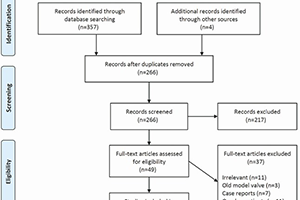Sutureless aortic valve replacement: a systematic review and meta-analysis
Abstract
Background: Sutureless aortic valve replacement (SU-AVR) has emerged as an innovative alternative for treatment of aortic stenosis. By avoiding the placement of sutures, this approach aims to reduce crossclamp and cardiopulmonary bypass (CPB) duration and thereby improve surgical outcomes and facilitate a minimally invasive approach suitable for higher risk patients. The present systematic review and metaanalysis aims to assess the safety and efficacy of SU-AVR approach in the current literature.
Methods: Electronic searches were performed using six databases from their inception to January 2014. Relevant studies utilizing sutureless valves for aortic valve implantation were identified. Data were extracted and analyzed according to predefined clinical endpoints.
Results: Twelve studies were identified for inclusion of qualitative and quantitative analyses, all of which were observational reports. The minimally invasive approach was used in 40.4% of included patients, while 22.8% underwent concomitant coronary bypass surgery. Pooled cross-clamp and CPB duration for isolated AVR was 56.7 and 46.5 minutes, respectively. Pooled 30-day and 1-year mortality rates were 2.1% and 4.9%, respectively, while the incidences of strokes (1.5%), valve degenerations (0.4%) and paravalvular leaks (PVL) (3.0%) were acceptable.
Conclusions: The evaluation of current observational evidence suggests that sutureless aortic valve implantation is a safe procedure associated with shorter cross-clamp and CPB duration, and comparable complication rates to the conventional approach in the short-term.
Cover






